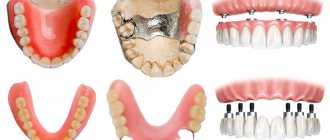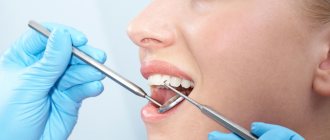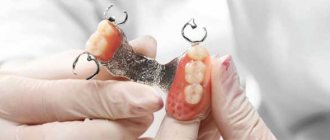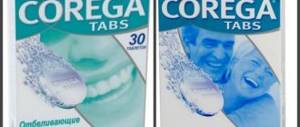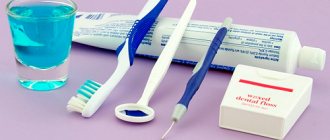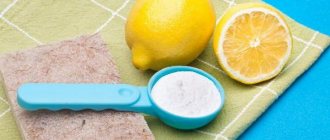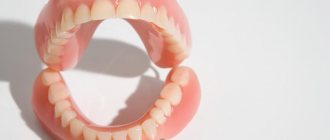Why do you need spacers for dentures: application features and review of popular brands
Article navigation
- Why are fixing gaskets needed?
- Main characteristics of products
- Pros and cons of use
- In what cases can and should gaskets be used?
- Contraindications for use
- What brands of products are available for sale?
- How to use fixing pads
Question for a specialist
Removable dentures do not always bring positive emotions - they can cause discomfort, especially during adaptation. Special gaskets for dentures, which fix the structure in the oral cavity and prevent the appearance of unpleasant sensations, help correct the situation.
Why are fixing gaskets needed?
Fixing spacers are used only for removable dentures. And they help eliminate the following problems:
- rubbing of the mucous membrane,
- foreign body sensation
- the appearance of irritation on the inner surface of the oral cavity,
- difficulty chewing,
- difficulty speaking,
- weak fixation of the product, loss.
Don't know what type of prosthetics to choose?
We will help in the selection, advise where to read more information and compare types of prosthetics.
Consultation with an orthopedic doctor in Moscow clinics is free! Call now or request a call
Working hours: from 9:00 to 21:00 - seven days a week
Due to the minimum possible thickness, the spacers do not affect the height of the bite. In addition, they do not change the taste of food and do not interfere with conversation. The use of products helps prevent all unpleasant sensations at the same time, so experts recommend using them immediately after prosthetics (if the situation was complicated and it is not possible to adjust the prosthesis so that it fits tightly to the gums).
Advantages
Orthopedic pads have certain advantages that set them apart from the general category of products for improving fixation and reducing discomfort.
The main advantages of this tool:
- provide ideal fixation of the prosthesis;
- significantly reduce the adaptation period;
- prevent inflammatory manifestations;
- do not change the height of the bite;
- allow the simultaneous use of medicinal ointments and gels;
- do not cause adverse reactions;
- allow you to fix the canvas even on deformed gums, thanks to the elasticity of the material.
Main characteristics of products
Various compounds can be included in the composition of dental dams, the main ones being: sodium alginate and carboxymethylcellulose. The first component ensures the retention of water molecules - by swelling, it improves shock absorption between the structure and the gum. It is of natural origin from algae and does not cause allergies.
Carboxymethylcellulose may cause an allergic reaction. The compound is intended to thicken the composition and stabilize the viscosity index. Also retains water.
The basis of the gaskets is polypropylene or viscose. Viscose fibers are characterized by excellent absorption capacity, porosity, and provide reliable adhesion to surfaces. Polypropylene fibers have a similar effect, but unlike viscose they are lint-free and more elastic. To enhance the fixing properties and provide additional lubrication, the material is additionally impregnated with petrolatum.
The retaining spacers for dentures differ in shape for the upper and lower jaws. For the lower rows they are made in a horseshoe shape, and for the upper rows - in the form of a semicircle.
On a note! Alginates are salts of alginic acid characterized by high hygroscopic properties. They attract and hold water molecules like collagen, a protein of animal origin, which is why such fixing pads are called collagen.
Pros and cons of use
Among the advantages of using fixing gaskets are:
- reduction of the period of adaptation to removable dentures,
- additional fastening of the structure to the gums,
- the possibility of parallel use of other means for fixation or treatment,
- preventing inflammation of the mucous membranes,
- no effect on bite height,
- possibility of use even in the presence of dental deformations,
- versatility and safety.
The products are practically free of flaws. Of the minuses, users note only the high cost, and the possibility of developing allergic reactions to some components. But this is extremely rare.
REPROSTHETICS WITH ACRYLIC PROSTHETICS - RUB 200,000.
Re-prosthetics with an acrylic bridge on a metal frame (all included) up to 12 units.
Save RUR 30,000. Call now or request a call
In what cases can and should gaskets be used?
Fixing spacers for dental prostheses are indicated during the patient's adaptation to the design. In addition, the doctor may prescribe the use of products in other cases:
- for abnormalities in the structure of the jaw that prevent the full use of dentures,
- when identifying chafing, ulcers, inflammation of the mucous membrane,
- with age-related changes in soft tissues,
- if there are disturbances in the functioning of the salivary glands (excessive or insufficient secretion),
- in case of malocclusion, when it is necessary to change the position of the removable structure.
Traumatic damage to the mucous membrane, such as a burn, can also be an indication. In this case, the gasket will protect the soft tissues from additional injury to the wound by the prosthesis and ensure speedy healing.
“Once I seriously damaged my gum with a fish bone, the doctor even had to cut it. Of course, it was not possible to wear a prosthesis because of the pain. The pads have helped a lot, now I keep them on hand and use them from time to time.”
Elena D., from correspondence on the e1.ru forum
Materials used
In dental practice, various types of gaskets are used, which are made from the following materials:
- Calcium hydroxide. The pronounced bactericidal effect prevents the penetration of infectious pathogens into the pulp chamber.
In addition to its protective function, calcium hydroxide has a stimulating effect on the formation of secondary dentin. Prolonged contact with air causes a loss of the positive qualities of the material. - Aqueous mixtures containing calcium hydroxide. Used when placing temporary fillings.
They are applied in a thin layer to the bottom of the carious cavity, after which they are dried. To prevent the hydroxide from penetrating into the pulp, the dressing is changed after 3-6 weeks. In this case, materials such as Calcipulp, Calasept, Calcium Hydroxide are used. - Varnishes have good insulating properties, but have weak healing properties. They contain calcium hydroxide, zinc oxide, resin impurities and solvent. The varnish is applied to the cleaned tooth cavity, after which it is auscultated with a weak stream of air.
- Chemically cured gaskets. These types of pastes are prepared by mixing calcium hydroxide and ether in a 1:1 ratio.
Provide good insulating properties for spot installation with composite materials. They behave differently with cement compositions, as they have different degrees of compression. - Light-curing polymers. Despite the high degree of strength, they are rarely used, as they can (if handled carelessly) cause burns to the pulp. Also, the compositions have little therapeutic effect.
- Zinc-eugenol pastes. Used as an antiseptic before installing temporary fillings. Do not use with composite materials (due to the effect of eugenol).
In the video, a practicing dentist will talk about the features of materials created on the basis of calcium hydroxide.
Contraindications for use
The main contraindication to the use of retaining spacers for dentures is increased sensitivity to the components included in the composition. Since every body is individual, even products labeled “hypoallergenic” can cause allergies.
It is not recommended to use gaskets if the service life of the removable structure has long expired or it is damaged. Lack of hygienic care for the oral cavity and dentures also serves as an obstacle to use.
Reviews, opinions, comments
Practitioners in the field of dentistry agree that, despite the variety of linings used, they prefer materials based on aqueous suspensions or with chemical curing based on calcium hydroxide.
You can leave your opinions and comments at this point in this article.
If you find an error, please select a piece of text and press Ctrl+Enter.
Tags toothache
Did you like the article? stay tuned
Previous article
Recommendations from experts on how to properly care for your mouth guard
Next article
At what age is it advisable to take a child to an orthodontist?
What brands of products are available for sale?
There are three manufacturers of retaining spacers for dentures on the market. As a rule, there are no problems with where to buy products - they are available for sale in pharmacies, online stores in the relevant field, and you can also purchase them on the website of the manufacturer or representatives.
- Protefix (“Protefix”): characterized by strong adhesion, good shock-absorbing properties, and elasticity. The fixing effect lasts up to 8 hours. Soft pads "Protefix" are excellent for use in cases of abnormalities of the jaw bone tissue. They require preliminary wetting and are placed on a damp prosthesis. The cost of products ranges from 270 to 500 rubles for 30 pieces,
- Fittydent (“Fittydent”): pads from this manufacturer keep the denture in the mouth for 12 hours, regardless of the amount of saliva, the need for rinsing and other factors. They have increased softness, therefore they are indicated primarily for people prone to inflammatory processes of the mucous membrane. They do their job perfectly even with narrow lower dentures. The pads are placed on the dry prosthesis. The price of products on average ranges from 320 to 550 rubles for 15 pieces,
- Denture Fixing Tape: available as individual strips or as a continuous sheet rolled into a roll. This makes it possible to provide the most suitable shape and size. The thickness of the gaskets does not exceed 1/2 mm. Fixation does not depend on the dryness of the surface of the prosthesis, but requires preliminary targeted application of a fixing agent (for example, Corega cream) in the front part of the structure and along the edges. The price of products ranges from 320 to 530 rubles.
Combined substances
Pastes can have different therapeutic effects, it all depends on the components. Most often their components are:
- medicated oils (sunflower, olive, peach) or fat-soluble vitamins (retinol acetate);
- fillers (zinc oxide, white clay);
- medicines.
Pastes have the following therapeutic effects:
- If the composition contains fluorides, collagen and calcium glycerophosphate, then such components will promote the formation of secondary dentin. This group of drugs is called odontotropic.
- The paste will have an anti-inflammatory effect and relieve swelling if it contains Hydrocortisone or Prednisolone. They relieve the severity of the inflammatory process, but at the same time reduce the growth rate of new dentin. Therefore, after their use, it is recommended to use substances belonging to group 1.
- Materials containing Chlorhexidine or Metronidazole have an antiseptic effect.
- When acute pulpitis or deep caries is diagnosed, a cushioning material containing enzymes (profezyme, stomatozyme) is used.
It should be noted! Combined pastes are used as a temporary healing material. This is due to their weak strength and poor curing.
The use of dental dams is an important point in the treatment of deep caries and pulpitis. They relieve the severity of inflammation and accelerate the process of regeneration of secondary dentin. This allows you to keep dental units healthy, ensuring the functionality of their tissues.
How to use fixing pads
To ensure optimal fixation of the gaskets, it is recommended to adhere to some rules for their use:
- the prosthesis must be clean,
- correction of products is carried out with scissors,
- Before use, you must remove the protective film,
- After placing the gasket on the surface of the structure, all gaps and air bubbles should be eliminated.
It is not advisable to eat or drink within 15-30 minutes after installing a prosthesis supported by such pads.
To fix removable dentures, you can use not only gaskets, but also other means and devices: powders, strips, adhesives, and so on. At the beginning of wearing the structure, the dentist will recommend the most suitable options, but the final choice can only be made through direct application.
Author: Matyushenko M. A. (Thank you for your help in writing the article and the information provided)
